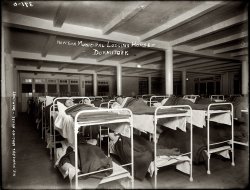
MAY CONTAIN NUTS

Search Shorpy
SHORPY ART

Framed or unframed, desk size to sofa size, printed by us in Arizona and Alabama since 2007. Explore now.
Join and Share
Ad-Free Shorpy
Shorpy is funded by you. Patreon contributors get an ad-free experience.
Learn more.

Recent comments
- If You’re Like Me, Never
- U.S.A.
- S&P
- 1940 Zenith radio model 6G601
- Quality goes in before the name goes on!
- Snazzy skirt
- Carbon Arc Lamps
- Illuminate us
- I remember it well
- I can't prove it
- Complicated then, forgotten now
- Bryan-Stevenson
- Skinny is as skinny does
- How do you rest in peace
- Riding the footboards
- Alas, hidden from view
- Baldwin Diesels
- Exclusive pump
- Bananas, Oysters and Smokey Joe
- Details, Details
- What's that building to the left of the tower?
- Coal Barges
- Bromo-Seltzer
- Inner harbor
- The Basin
- What a headache!
- Giant stepladder?
- Yeah, it was cold
- Love those coats
- Link & Pin Days Remnant
Member Photos
The Shorpy
Print Emporium
Print Emporium
Search Shorpy
Search results -- 30 results per page
- Coat Check: 1909
- New York municipal lodging house circa 1909. "Fumigating clothing." From the New York Times: ... you could present anyone with a plan like that today.
Lodging House So, reading the NY Times article carefully, you would: ... Posted by Dave - 09/09/2011 - 2:20pm -
![Coat Check: 1909 New York municipal lodging house circa 1909. "Fumigating clothing." From the New York Times: "There is a basement and subbasement, the latter containing the boiler and batteries for lighting and heating. The basement contains the shower baths for men and the steam and formaldehyde cleansers, the laundry, and the vacuum sweeping apparatus. ... All applicants for accommodations will be forced to undress before going to their rooms, which they will enter after they have taken a bath and their clothes have been thoroughly fumigated. The arrangements for the latter are most novel. The clothes are placed in small crates or boxes, which are then wheeled into large steam and formaldehyde retorts. When they are finally taken from their place before the men and women to which they belong are ready to leave the house in the morning, they are entirely cleaned." 8x10 glass negative, George Grantham Bain Collection. View full size.
Scary scenarioI don't think you could present anyone with a plan like that today.
Lodging HouseSo, reading the NY Times article carefully, you would: petition to spend the night, wash up vigorously, then leave your clothing in the basement while you join the other exclusive guests. In the morning, men and women exit the boarding house looking crisp and dapper. Sounds like a pretty wild place...
Seriously, what DID they wear?
[A nice Department of Public Charities nightshirt. - Dave]
LiceAmazing setup. I think the fumigation was to kill the lice in their clothes. Typhus was a serious problem back then, as well as other louse borne diseases.
(The Gallery, G.G. Bain, NYC)](https://www.shorpy.com/files/images/01799u_0.thumbnail.jpg)
- Night and the City: 1917
- January 18, 1917. "New York Municipal Lodging House. Waiting for the doors to open." View full size. 8x10 glass ...
NYMLH 1991 New York Times article on the Municipal Lodging House.
Excerpt:
IF Mayor David N. Dinkins has been ... Posted by Dave - 09/09/2011 - 7:49pm -
![Night and the City: 1917 January 18, 1917. "New York Municipal Lodging House. Waiting for the doors to open." View full size. 8x10 glass negative, George Grantham Bain Collection.
Hatsit's a real sign of the times that no matter how down on your luck you were, you always wore a hat.
NYMLH1991 New York Times article on the Municipal Lodging House.
Excerpt:
IF Mayor David N. Dinkins has been perturbed by the opposition to his plan for 100-bed shelters for the homeless, he would surely take a suggestion for a facility 10 times that size as a bad joke.
Yet that is exactly what New York City put up in 1909 at 432 East 25th Street. This shelter stood for 40 years but the chilling irony is that the 1909 Municipal Lodging House remains the only city building built in Manhattan for single homeless men and women.
Homeless ShelterThat's a lot of tenants who did not have the freedom to get into their own bed until someone else said they could!
I'd love to learn more about this one too.
[So far we have six photos of the New York Municipal Lodging House, with more information in the comments. - Dave]
ShelterThe hangdog expression on the policeman's face speaks volumes. What was the story on the New York Municipal Lodging House? Sure seems like a popular place.
Covered FacesIt's also very interesting to note that a number of men have purposefully covered their faces or lowered their heads, as if to not be identified. It's also interesting to note the group of men standing off to the right toward the back of the picture. Why have they remained separate? Just interesting.
LiteraryReminds me of Down and Out in Paris and London. Many scenes just like these with all the "tramps" waiting to see if they would be allowed in for the night
(The Gallery, G.G. Bain, NYC)](https://www.shorpy.com/files/images/01803u1_0.thumbnail.jpg)
- Devine's Place: 1905
- ... there are the Scandinavien Boarding House, Zenith Lodging and the Sven (?) Hotel. And they all look a little rough around the ... 1959. - Dave]
City Gas Duluth must have had a municipal gas system in those days. Above the Blatz building you can see the ... Posted by Dave - 08/13/2012 - 6:57pm -
![Devine's Place: 1905 Circa 1905. Our latest installment from the Duluth, Minnesota, panoramic series. Anyone for a round of Blatz? Detroit Publishing glass negative. View full size.
That street in the foregroundis probably the kind of place that your mom would tell you to never walk down.
Trolley wireI have never seen a trolley wire suspension system like the one in the photo. Maybe there weren't enough wooden poles so they resorted to the iron poles and arches, but it would seem that insulation of the wires from the ground would be difficult. Anyone seen this system in any other Shorpy photos?
WonderfulThere are two really superb looking Victorians at the middle horizon that would be well worth a second look. Charles Addams could have been the architect! Grand! Is that Andy's place?
I'm buying but ...it'll have to be the hometown Fitgers, or at least the cross-port rival, Superior.
I'll take a passon that Blatz. But I could really go for an ice cold Battle Ax!
Battle Ax -- The beer that made Duluth, well, Duluth!
Well goshNow I have an urge to go grab me a chew of "Mail Pouch." Isn't advertising wonderful?
Still standingThe dark church and the Fitgers smokestack are still there in this panorama: http://upload.wikimedia.org/wikipedia/commons/f/f9/Skyline-Duluth-200603... Now I have a hankering to visit Grandma's Saloon again for old time's sake. It was a day trip from my home town of Minneapolis, but it's a long ways from where I live in Texas now. Sigh.
I'm surprisedthat Dave didn't name this photo "(S)hoes and rubbers" but that might have been just a too bit racy.
Pleasantly SeedyNotice how The Builder's Supply building in the foreground has a first floor below the road. I wonder if all of the buildings on the other side of the bridge approach - including Devine's Place - at one time had first floor storefronts and then the buildings were modified once the bridge was built.
Just a wonderful, wonderful picture.
The beer made in Superior...was Northern.
Duluth had a couple other breweries besides Fitger's Brewing (Fitger's & Rex Beer). Duluth Brewing & Malting (Royal Bohemian, Stag, Moose & Karlsbrau Beer) & Peoples Brewing (Peoples, Regal Beer, Olde English 600 Stout). All brand are gone except Olde English 600, which still lives on as Olde English 800 Malt Liquor.
Battle Axwas a brand of chewing tobacco. If "Mail Pouch" wouldn't turn off chaw customers, why would "Battle Ax"? A complete version of a wall painting, courtesy of Olivander's Flickr site, is below.
Well engineeredThe guy who designed the elaborate chimney flu on the building next to the hotel was determined to not let one tiny bit of rain or snow get down into the house.
[Achoo. - Dave]
Luxe accommodationsIn just a single-block stretch of seven or eight storefronts there are the Scandinavien Boarding House, Zenith Lodging and the Sven (?) Hotel. And they all look a little rough around the edges. I imagine these fine establishments were most often frequented by merchant seamen coming ashore after crossing Lake Superior, before reloading the next day to head back east through the Great Lakes, perhaps all the way to the St. Lawrence Seaway. They were probably a little rough around the edges as well. Great photograph.
[The St. Lawrence Seaway didn't open until 1959. - Dave]
City GasDuluth must have had a municipal gas system in those days. Above the Blatz building you can see the frame for storage.
Norse StreetThis looks like a real Scandinavian street, with the Scandinavien Boarding House, Svea Hotel, Northland restaurant and A.W. Anderson's shop. Maybe that's one of my immigrant great-grandfathers sitting under that awning.
I'm curious where the dirt road that goes under the bridge leads to, though.
Fire!In the middle left are the ruins of a building that looks like it burned down.
Duluth had what this country neededA good 5 cent cigar!
Star of DavidI see a Star of David symbol in three locations: on the Blatz Brewery sign, on a storefront just to the right of the Northland Restaurant, and on the side of the large white building at upper left. Was there a significant Jewish presence in 1905 Duluth or does the symbol indicate something else?
[In Germany, the hexagram or Bierstern (beer star) was a symbol of the brewers' guild. - Dave]
Flimsy trolley polesThe trolley poles are amazingly flimsy. They look like they're made out of steel water pipe. The insulators look about the size of those used for low voltage telephone wires. I can only see one street light (at the right) so it must have been dark at night. I don't think the trolley poles would survive a midnight collision with a hefty Scandinavian dock worker full of Blatz.
ChurchvilleI can see at least four steeples in this shot as well as the building with the onion dome might be one (I am inclined to think it's a hospital or a school). Just how much "churchin'" did one town need?
Did anyone notice the Coca Cola sign on the left?
Also, judging by the size of some of the mansions in town, there was some serious money in Duluth at this time.
Stables!Finally spotted a stable! J. Hammel & Co, sale and exchange stables. Would love to see a close up of it or other stables from long ago for that matter!
Points of interestThe large white building with the Star of David at the left edge of the photo is the local Orthodox synagogue in Duluth, still standing and in service.
The onion dome sits on top of the Masonic Temple Opera Building, built in 1889 on Superior Street. The dome was later removed so as not to "mock the Classic purity of the Orpheum Theater" being built next to it on the avenue, according to a local architectural guide.
Those trolley polesI saw a couple of comments about the trolley wire infrastructure and I've lived in a city that still has streetcars my whole life, so hopefully I can clear a bit up:
The insulators don't look that big in the picture and they don't look that big from the ground either, when you're standing on the sidewalk looking up. The are substantial pieces of porcelain when you're holding one in your hand. Also, they only need to insulate against 600 volts DC, which isn't that high.
With respect to the support poles, they're probably painted steel poles. Notice that they are only carrying the span wires and trolley wires above the tracks as well as some DC feed circuits. They aren't carrying nearly as many circuits or heavy objects like transformers that the electric utility poles are. Poles like the ones in the picture have lasted between 60 and 80 years at home.
The support poles have to be installed on a slight angle, leaning away from the street, when they're installed because the tension of the overhead wires above the tracks and the span wires supporting them tends to pull the poles in towards the street. If you look closely at the support pole at the far right of the picture on the sidewalk closest to the camera, you can see it bending in towards the street. That suggests that it either wasn't installed correctly or (more likely from the way the pole appears bent) the span wire' tension's much too high...
Streetcar wire like that's one thing that hasn't changed much over the last 100 years and the stuff hanging above the tracks a block from where I'm writing this looks the same in 2009 as it does in the picture from 1905.
A Battle Ax in Indianapolishttp://www-lib.iupui.edu/static/exhibits/circle/exhibit3_1.html
While on an entirely different expedition, I just came across another old photo showing a 'Battle Ax' mural, right here in my hometown. Thought I'd share...
http://www-lib.iupui.edu/static/exhibits/circle/exhibit3_1.html
Did the streetcar company have one of these?I've just come back from holiday in Greece. Trams and trolley buses are alive and well in Athens and Pireaus. The modern trolley poles look pretty substantial, but here is a delightful 1910 photo (courtesy of the ISAP archives) of a horse drawn tower wagon for inspecting the tram wires on the Pireaus waterfront. The Duluth trolley poles at the right of your picture look very similar to the one on the left of this one and the insulator is indeed very small. I wonder if the Duluth streetcar company had such a handy vehicle?
Panoramic Duluth1890s. Click to enlarge.
(The Gallery, Boats & Bridges, DPC, Duluth, Railroads)](https://www.shorpy.com/files/images/4a06769a.thumbnail.jpg)
- Bread and Coffee: 1909
- ... & Coffee." The new Department of Public Charities municipal lodging house at 432 East 25th Street in New York, which opened in February ... Posted by Dave - 09/09/2011 - 2:21pm -
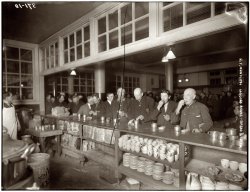
- Dormitory: 1909
- February 1909. Men's dormitory at the New York municipal lodging house. 8x10 glass negative, George Grantham Bain Collection. View ... Posted by Dave - 09/09/2011 - 2:26pm -
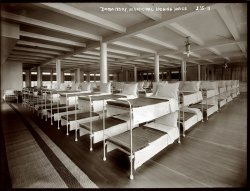
- After the Bath: 1909
- New York City municipal lodging house circa 1909. "After the bath." This is the answer to those ... Posted by Dave - 09/09/2011 - 2:27pm -
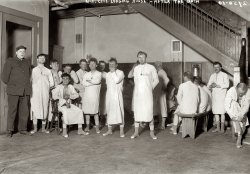
- Some of the Babies: 1914
- December 15, 1914. "New York Municipal Lodging House. Some of the babies." View full size. 5x7 glass negative, ... Posted by Dave - 09/09/2011 - 7:49pm -
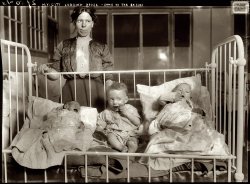
- Lights Out: 1914
- January 9, 1914. Men's dormitory at the New York Municipal Lodging House. View full size. 8x10 glass negative, George Grantham Bain ... Posted by Dave - 09/09/2011 - 7:52pm -
